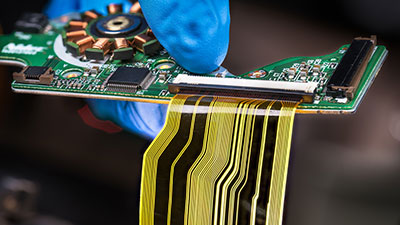You have probably come across a simple siren circuit since it is in all alarm systems. For instance, a fire truck will produce a siren as it passes to be granted passage in traffic. The same also applies to an ambulance siren.
Noteworthy, the working principle behind the production of the siren sound is simple. We'll introduce the fundamental operating mechanism of custom siren sound. Further, we'll elaborate on making a cheap siren using readily available materials.
Therefore, read on for a thorough explanation of the ambulance siren circuit operation. Additionally, we'll expound on brigade sirens, among others.
Contents
Simple Sirens Circuits Examples
There are various variations of simple siren circuits, depending on their intended use. We will look at some of the standard electronic siren circuits at length. They include the following types:
Police Siren Circuit using 555 timers
A police siren
The primary components in the police siren circuit are the two 555 timer ICs. Note, after complete assembly of the course, expect the generation of an up-down wailing sound. It is a sound that is common with police vehicle sirens.
During connection, ensure that you wire both ICs as astable multivibrators. Also note, the astable mode is imperative in facilitating the delivery of a continuous sequence of pulses. Additionally, there will be output signal (s) on the output pin of the circuit via a connected speaker.
Police Siren Circuit Diagram
The first IC 555 is connected as a low-frequency astable oscillator. On the other hand, the second IC 555 acts as a fast astable Oscillator.
You can also modify Siren's frequency range by altering the values of resistances. A potentiometer variable resistor is handy in this process. Instead of using the two IC 555 timers, you can also use a single NE556 IC.
The rationale of this option is that a NE556 IC features a dual 555 timer. Thus, it will operate in the same manner as when you use the two IC 555 timers. It will lead to a loud noise which is essential during police patrols. Additionally, it is possible to amplify the output sound via an audio amplifier.
Audio amplifier
Noteworthy, it's possible to assemble this circuit on any general-purpose PCB or Vero board. Here is a list of the components that you'll require:
- One 68K resistor
- Two 555 timer ICS
- Three 10K resistors
- One 1K resistor
- Two 10uf capacitors
- Two 0.1u (104)capacitors
- One external speaker
Special Offer: Get $100 off your order!
Email [email protected] to get started!
Simple Siren using 2N2907 Transistor
A siren
The mechanical siren design is easy to build with two critical transistors. They include the 2N2222 and the 2N29097. 8-ohm size loudspeakers are enough for the output frequency to produce the intended sound.
Alternatively, you can opt to use an old loudspeaker that is poor at playing music. Its audio frequency may be lacking in harmony. But this system is different as it simply aims to produce a loud siren sound.
Among the parts that you'll require for this circuit include the following:
- 2 Transistors- A 2N2222 and 2N29097.
- A 22uFwith electrolytic capacitor.
- A 0.47uF electrolytic or ceramic capacitor.
- 3 Resistors with resistances of 39K, 47K, and 22K.
- A speaker- Preferably 8-ohm speaker 0.5W.
- A switch-push button type
Check out the circuit diagram:
Simple Siren using 2N2907 Transistor
Ship Siren Circuit
A speaker on a ferry
If you've been around a port, you've probably heard the loud ship siren sound. Such mega sirens require a sophisticated circuit, but you can still make one with the key components. Note, you can operate the course using a low power output source.
Nonetheless, to ensure a sound noise-making siren system, including a power amplifier, is imperative. It will amplify the sound to provide an output signal that resembles a real ship.
This configurable Siren is based around a multivibrator and two transistors. Therefore, the basis of its operation is similar to that of the other circuits we've just covered. Nonetheless, this additionally features a low power output stage.
The presence of a third transistor facilitates the latter. Also noteworthy, the ideal speaker for this circuit has an impedance of approximately 40-80 ohms.
Additionally, the circuit features two capacitors. Their role is to control the pitch intensity of the Siren. A simple assembly using the components illustrated in the circuit diagram below will yield a siren of approximately 300 Hertz.
Circuit Diagram
Ship siren circuit
Also, note that this circuit's quiescent current is relatively low. Thus, the ship siren sound may not be as pronounced as you may want it to be. Still, you can improve the sound quality by integrating the collector output of the Transistor denoted Q2 with another amplifier's input.
Note: Make sure you include a 1µF electrolytic capacitor in this integration. Also, you need to make sure that you align it in a series arrangement with a 12k resistor.
Applications of simple sirens
- In fire engines
- On ambulances to signal other road users to give way
- They are present in police cars to scare off criminals
- Useful in security systems such as alarm devices
Simple sirens with special flashers
Conclusion
We have covered the working principle of one of the most common external devices in security systems. We have delved into a few standard sirens' finer workings. As you have realized, the assembly is easy.
Nonetheless, consider using an audio amplifier if you want better sound quality. Also, remember we are your trusted ally in electronics. Thus, talk to us if you have any queries on simple sirens and other circuits. We'll respond within the shortest possible time frame.
Special Offer: Get $100 off your order!
Email [email protected] to get started!












